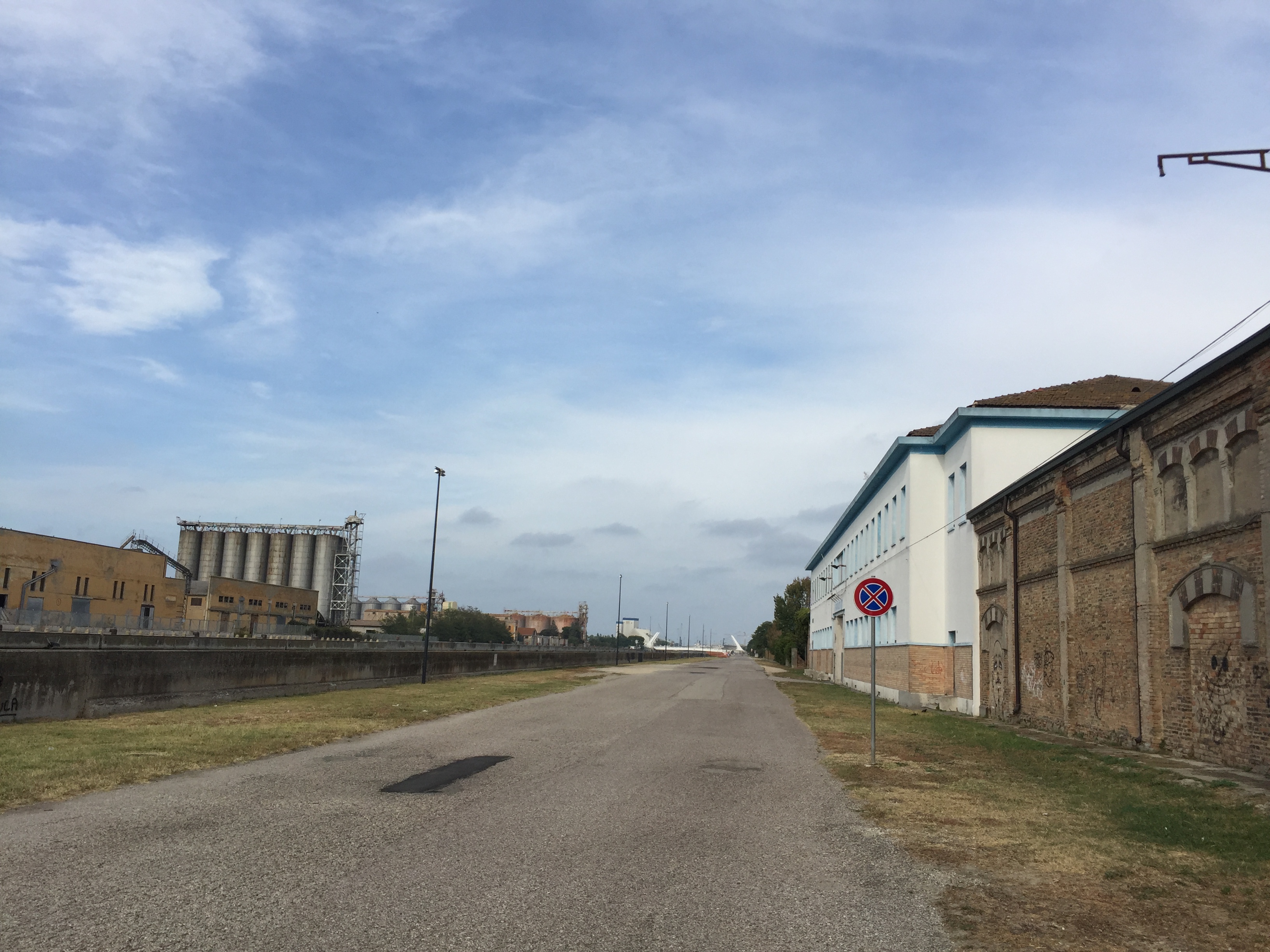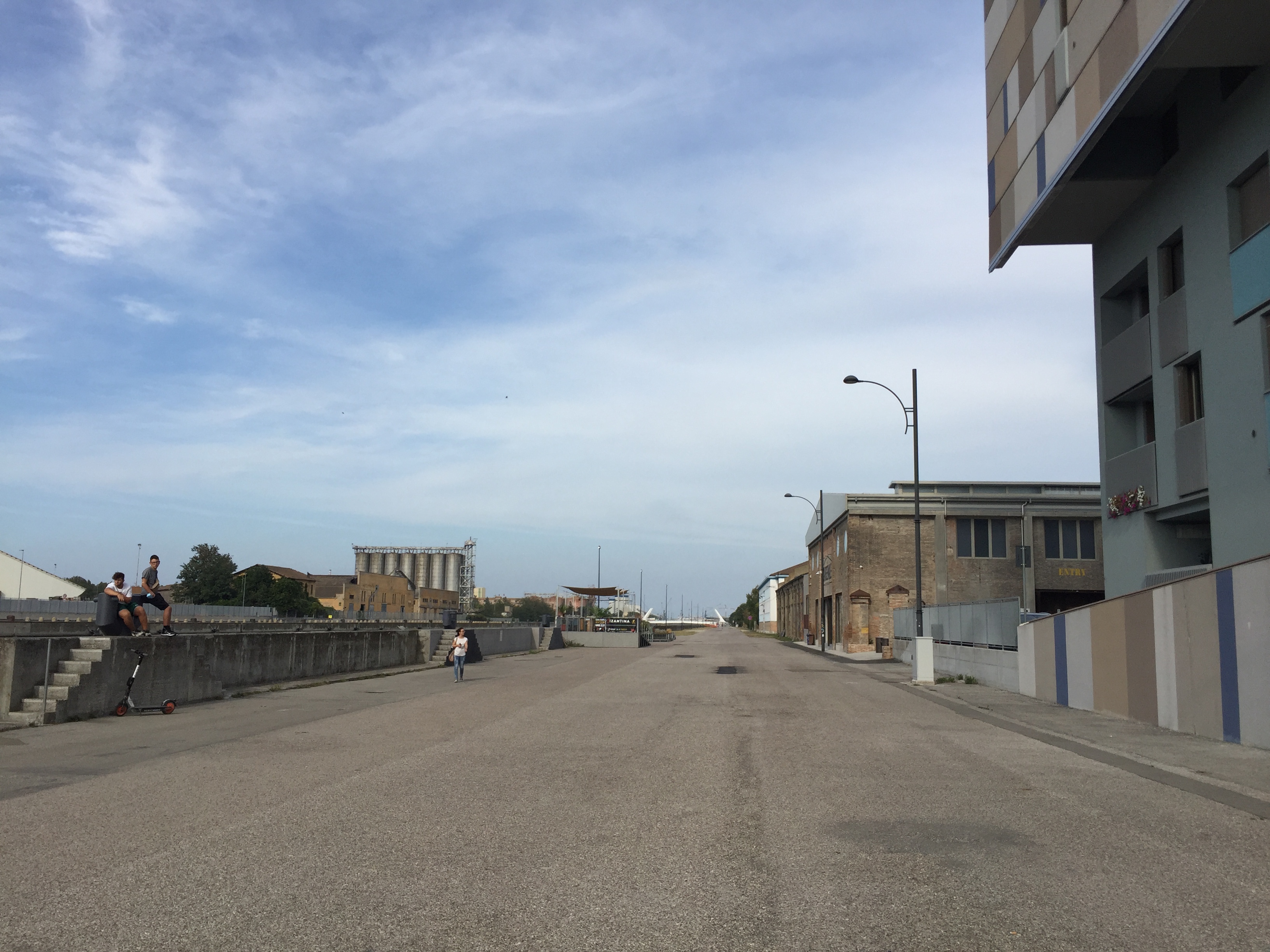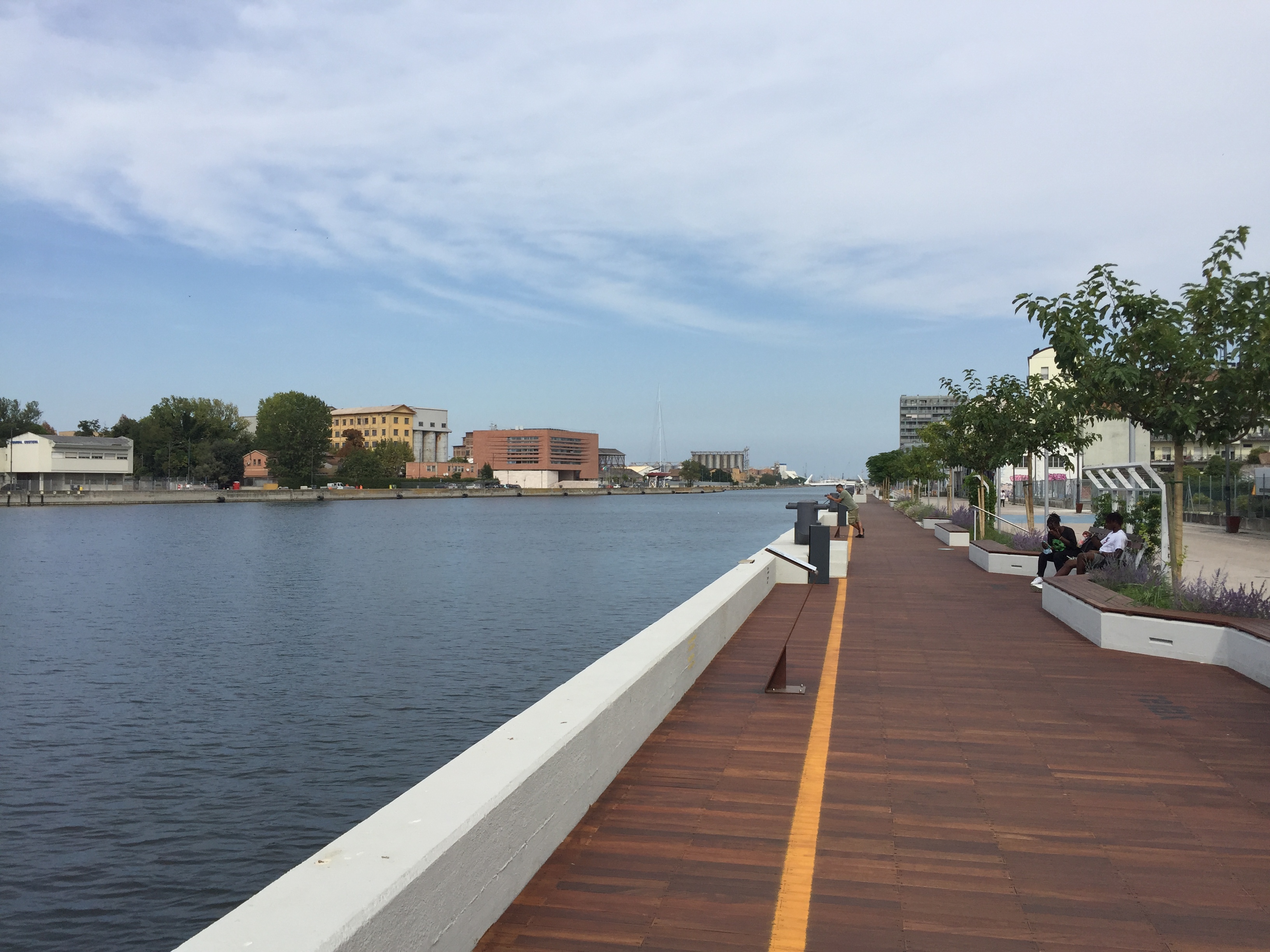Re-appropriating Ravenna’s waterfront: towards a collective story of transformation

It takes only a few minutes’ walk from Ravenna’s city centre, and I find myself in a completely different world. Walking through a few of the city’s historical streets, I arrive to the main station and descend to an underpass to cross under the railway tracks that cut the city in two. This is indeed a strong, symbolic border that separates the Ravenna of the Byzantine mosaics and renaissance palaces from the Ravenna of the Adriatic Sea, with its waterways, industrial facilities and open horizons. When I arrive to the Candiano Canal, Ravenna’s former port, I have an eerie feeling: a combination of a sense of abandonment and the sensation of unlimited freedom, as if I was liberated from the centuries-old rules of the historical city. On my right, skeletons of abandoned industrial buildings alternate with new, out-of-the-context residential development projects, early birds of the port’s changing fortune. On my left, a new boardwalk borders the canal, as a promise to further this change that feels long overdue, pulling youngsters out of the centre in their search for a wilder, edgier, more contemporary Ravenna. This is the Darsena, Ravenna’s neighbourhood along the canal that connects the city to the Adriatic Sea, and the focus area of the municipality’s Urban Innovative Actions-funded project DARE.
It is a warm but cloudy September afternoon at the canal. I meet Morena Brandi, the Ravenna Municipality’s responsible for DARE and Emanuela Medeghini, project coordinator, at coLABoRA, a co-working space and incubator initiated by the Ravenna Municipality and a group of foundations and public entities. After an interview in one of the meeting rooms of the renovated, yellow, one-storey building, we set out to explore the neighbourhood and walk along the canal. The area is mostly deserted, but not completely: besides a few joggers and dog walkers, most people are concentrated in Darsena Pop Up, a temporary beach bar installed around a few repurposed shipping containers. Together with coLABoRA and a few other cultural and commercial venues, Darsena Pop Up is one of the pioneers of the area, conceived to help turning Darsena into a destination for the city’s young and restless. Another group of youngsters is gathering at the boardwalk installed along the inner part of the canal. They are sitting with an eye on the canal, a comforting, almost hypnotic sight. “We consider ourselves a seaside city precisely because of this neighbourhood,” says Morena Brandi, asking herself, „how is it possible that Ravenna neglected so much its relationship with the sea?”

For decades, the Darsena area has been a delicate spot on the city’s map. It was once the city’s productive harbour with a collection of port facilities, industrial buildings and warehouses from the 1800s. To support the port’s operation and industrial production in the area, a workers’ district had evolved around the canal, with its social housing and pavilions. However, the area remained disconnected from the rest of the city: the road grid was designed for industrial, commercial and military purposes, while most civilians lived on the other side of the railway tracks. Between the 1960s and the 1990s, the whole harbour moved to a new site, further out on the way to the sea. As a consequence, many buildings in the Darsena area that contributed to the harbour’s daily operation lost their function. With the Candiano Canal no longer navigable, warehouses and companies that used water for transport also shut down their activities.
The area’s physical isolation from the rest of the city did not help its reputation. This isolation is manifold: besides its physical and infrastructural distance from the centre, it is also separated by public perception. “In the 1990s the Darsena had become a degraded area,” recounts Morena Brandi, “and the area is still experienced as a neighbourhood where mainly immigrants live, which is statistically not true.”

While the Port Authority is still operating at the left bank of the Candiano Canal, other public buildings have been renovated, and a few new residential projects have been erected on the right bank, the area is still characterised by abandoned buildings belonging to dozens of different owners. Most of these owners have no short-term or long-term plan with their properties, other than speculation: “It is more convenient for them to keep their buildings and wait for the increase of property values in the Darsena, benefitting from private and public investment in the area,” clarifies Emanuela Medeghini.
The reluctance of private developers to open the way to the Darsena’s renewal gave the municipality the responsibility to spearhead the process. The regeneration of the area has been on the city’s agenda for decades, situated at the centre of various urban renewal concepts. “We have urban development programmes, state funding already from twenty years ago,“ Valentino Natali, head of urban planning at the Ravenna Municipality, tells me after joining us for the walk, adding that “this vision has never completely changed.” Successive urban plans all agreed on the need to reconvert the production plants that are now almost completely abandoned. The area’s reconversion went ahead in fits and starts. In 2004, the prominent architect Stefano Boeri created a masterplan for the Darsena but it was considered too ambitious and was not approved by the city council. Following the creation of a public-private agency for the promotion of real estate investment in the area, a participatory planning was launched, with a focus on the architecturally most interesting waterfront area. The municipal masterplan that came into force in 2015 and expired in March 2020, provided for the conversion of industrial spaces into residential buildings at the waterfront, but only with partial results, resulting in classical housing projects. While the masterplan failed to bring the desired change to the area, the impact of the few built private architectural projects have remained modest, forcing the municipality to look for another logic of regeneration. “They have always worked on improving the architectural aspect of the neighborhood as if only through renovation the magic could happen,” explains Morena Brandi.

More than grandiose development projects, the smaller initiatives that quickly populated the area brought fresh air to the area. In 2015, the city council approved a municipal regulation on temporary use, facilitating the re-use of vacant properties by social and cultural initiatives. This regulation opened up opportunities for a variety of activities in the Darsena area. In 2016, the municipality joined forces with the Enrico Mattei Foundation to turn the old harbour master’s office near the canal into a creative space. This led, in July 2016, to the inauguration of coLABoRA, a co-working space hosting four start-ups from the fields of culture, creative industries and tourism – in the building that marked the beginning of our Darsena walk. Later that year, another spectacular temporary venue opened barely a minute walk away from coLABoRA: Darsena Pop Up opened in September 2016, transforming a 4000 m2 stone deposit into a sports and events centre, a beach and a square with the help of a few shipping containers serving as temporary buildings on the site. In the past five years, these spaces and the mushrooming new activities around them brought many new people into the area. The municipality capitalised on this new attention: in July 2020, benefiting from a temporary relaxation of the Covid-19 lockdowns, a brand-new wooden boardwalk was inaugurated that runs more than a kilometre along the canal, allowing residents to finally access the waterfront.

These are the visible traces of the Darsena’s transformation. When we walk back to the station after the hours-long stroll, the air is cooler and the teenagers have vanished from sight. The boardwalk is deserted and so are the bars and restaurants that have popped up along the canal in the past years. On this Monday evening, public life seems to be withdrawn to the city’s historical centre.
But there is also an invisible side to the Darsena’s regeneration. The Darsena’s difference from the historic centre is also the source of its attractiveness: in social networks, there is a lot of attention to the Darsena nowadays. Besides the industrial heritage, abandoned buildings and the wooden boardwalk, the other material from which the new Darsena is built consists of these memories, images, emotions, desires, knowledge and connections. This is also the material that the DARE project works with. In the course of the project’s three years, Ravenna is cooperating with the Darsena’s residents, businesses, initiatives and institutions to create an inclusive, accessible digital framework for the area. This framework will help the Darsena population to better understand their area, develop new skills, improve their quality of life and become protagonists of their neighbourhood. Such a knowledge- and people-based strategy will support the physical transformation, for no real change happens without a shared story. “The storytelling of the process and of the area is an integral part of the regeneration process,” explains Emanuela Medeghini. It is the changing self-image of a neighbourhood and the improved opportunities of its residents that gives sense to the new architecture. This task is not inconceivable. “We all have personal memories that we walked along the Candiano when we were little and felt the desire to join an adventure. There is a sense of re-appropriating a piece of the city's history and we have begun to work on it,” recalls Morena Brandi as we leave the canal and walk back to the station.






















